| Aphis nerii | |
|---|---|
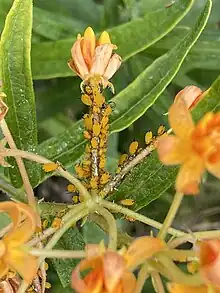 | |
| A colony of Aphis nerii | |
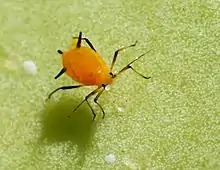 | |
| An individual Aphis nerii | |
| Scientific classification | |
| Domain: | Eukaryota |
| Kingdom: | Animalia |
| Phylum: | Arthropoda |
| Class: | Insecta |
| Order: | Hemiptera |
| Suborder: | Sternorrhyncha |
| Family: | Aphididae |
| Genus: | Aphis |
| Species: | A. nerii |
| Binomial name | |
| Aphis nerii Fonscolombe, 1841[1] | |
| Synonyms | |
|
Aphis lutescens Monell, 1879 | |
Aphis nerii is an aphid of the family Aphididae.[2] Its common names include oleander aphid, milkweed aphid,[3] sweet pepper aphid,[4] and nerium aphid.[5]
Distribution
The oleander aphid is widespread in regions with tropical and Mediterranean climates.[6][7] In Poland, oleander aphid has only been reported from a glasshouse.[8] Small populations of oleander aphid are present in gardens in London, England.[9]
Lifecycle
Female aphids lay live young (nymphs), a process known as viviparity.[6] Female aphids reproduce by parthenogenesis, males have never been observed in the wild but have been produced under laboratory conditions.[10] Females may be wingless or winged (alate), the production of the alate form occurs a higher rate in those regions where it is necessary for oleander aphid to migrate each year on to temporary hosts.[11]
Oleander aphid has a wide range of hosts, but mainly feeds on plants in the dogbane family, including milkweeds, oleander and periwinkle.[9] It is occasionally recorded feeding on plants in the bindweed family, daisy family and spurge family as well as rarely being recorded on Citrus.[12]
Virus Vector
Oleander aphid can act as a vector of viruses in the genus Potyvirus and Cucumovirus. The following viruses are known to be vectored by oleander aphid:
- Araujia mosaic virus[13]
- Bean yellow mosaic virus[14]
- Bittergourd mosaic virus[15]
- Citrus tristeza virus[16]
- Cucumber mosaic virus[17]
- Lentil mosaic virus[18]
- Papaya ringspot virus[19]
- Tobacco etch virus[20]
- Watermelon mosaic virus[21]
- Zucchini yellow mosaic virus[22]
Photos
 Colony on Nerium oleander
Colony on Nerium oleander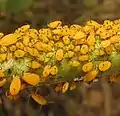 Colony on Asclepias syriaca (common milkweed)
Colony on Asclepias syriaca (common milkweed)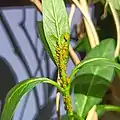 Colony on Asclepias curassavica
Colony on Asclepias curassavica Colony on Asclepias oenotheroides
Colony on Asclepias oenotheroides Colony on Asclepias syriaca inflorescence
Colony on Asclepias syriaca inflorescence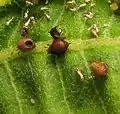 Mummified aphids, parasitized by Aphidiinae wasp, probably Lysiphlebus
Mummified aphids, parasitized by Aphidiinae wasp, probably Lysiphlebus
References
- ↑ "Aphis nerii Boyer de Fonscolombe, 1841". Global Biodiversity Information Facility. Retrieved 18 July 2014.
- ↑ "ITIS standard report - Aphis nerii (Fonscolombe, 1841)". Integrated Taxonomic Information System. Retrieved 17 July 2014.
- ↑ "IFAS - Featured Creatures - oleander aphid - Aphis nerii (Boyer de Fonscolombe)". Institute of Food and Agricultural Sciences. University of Florida. November 2001. Retrieved 17 July 2014.
- ↑ "Datasheet - Aphis nerii". CAB International. 22 August 2013. Retrieved 17 July 2014.
- ↑ "Aphis nerii (Boyer de Fonscolombe)". National Bureau of Agriculturally Important Insects. Indian Council of Agricultural Research. Archived from the original on 25 July 2014. Retrieved 17 July 2014.
- 1 2 McAuslane, HJ (2001). "oleander aphid". University of Florida. Retrieved 31 May 2018.
- ↑ "Aphis nerii (sweet pepper aphid)". CABI. 2018. Retrieved 31 May 2018.
- ↑ Osiadacz, B; Roman, H (2012). "The Update of "Systematic Review of Aphids (Hemiptera: Sternorrhyncha: Aphidomorpha) of Poland with Host Plant Index" (PDF). Wiadomości Entomologiczne. 31: 230–241. Retrieved 30 May 2018.
- 1 2 Tuffen, Melanie (2015). "Rapid Pest Risk Analysis (PRA) for: Aphis nerii". Defra. Retrieved 30 May 2018.
- ↑ Takada, H; Miyazaki, M (1992). "Occurrence of Sexuales of Aphis nerii B. de F (Homoptera: Aphididae) in Japan". Applied Entomology and Zoology. 27 (1): 117–124. doi:10.1303/aez.27.117. Retrieved 2 June 2018.
- ↑ Groeters, Francis (1989). "Geographic and clonal variation in the milkweed-oleander aphid, Aphis nerii (Homoptera: Aphididae), for winged morph production, life history, and morphology in relation to host plant permanence". Evolutionary Biology. 3 (4): 327–241. doi:10.1007/bf02285263.
- ↑ "Aphis nerii (Boyer de Fonscolombe)". The Hebrew University of Jerusalem. Retrieved 2 June 2018.
- ↑ Waipara, NW; Winks, CJ (2006). "Surveys for potential biocontrol agents for moth plant in New Zealand and Argentina". New Zealand Plant Protection. 59: 1–6.
- ↑ Skaf, IS; Makkouk, KM (1988). "Aphid transmission of Bean yellow mosaic and Bean leaf roll viruses in Syria". Phytopathologia Mediterranea. 27 (3): 133–137.
- ↑ Nagarajan, K; Ramakrishnan, K (1971). "Studies on cucurbit viruses in madras state - II. Vector-virus relationships of the bittergourd mosaic virus". Proceedings of the Indian Academy of Sciences, Section B. 73: 84–95.
- ↑ Cambra, M (2000). "Detection of Citrus Tristeza Virusby Print Capture and Squash Capture PCR in Plant Tissues and Single Aphids". International Organization of Citrus Virologists Conference Proceedings (1957-2010). 14: 42–49.
- ↑ Hobbs, H (2000). "Solanaceous weeds as possible sources of Cucumber mosaic virus in Southern Illinois for aphid transmission to pepper". Plant Disease. 84 (11): 1221–1224. doi:10.1094/pdis.2000.84.11.1221. PMID 30832171.
- ↑ Kumar, R; Mohan, J (1994). "Transmission of lentil mosaic virus". Legume Research. 17: 217–221.
- ↑ Mora-Aguilera, G (1993). "Development of a prediction model for papaya ringspot in Veracruz, Mexico". Plant Disease. 77 (12): 1205–1211. doi:10.1094/pd-77-1205.
- ↑ Cerkauskas, R (2005). "Tobacco Etch Virus" (PDF). AVRDC. Retrieved 3 June 2018.
- ↑ Srivastava, D. "Identification of a potyvirus associated with mosaic disease of Catharanthus roseus and its histopathogical effect". Medicinal Plants-International Journal of Phytomedicines and Related Industries. 4: 23–27.
- ↑ Katis, N (2006). "Transmission of Zucchini yellow mosaic virus by Colonizing and Non‐colonizing Aphids in Greece and New Aphid Species Vectors of the Virus". Journal of Phytopathology. 154 (5): 293–302. doi:10.1111/j.1439-0434.2006.01096.x.